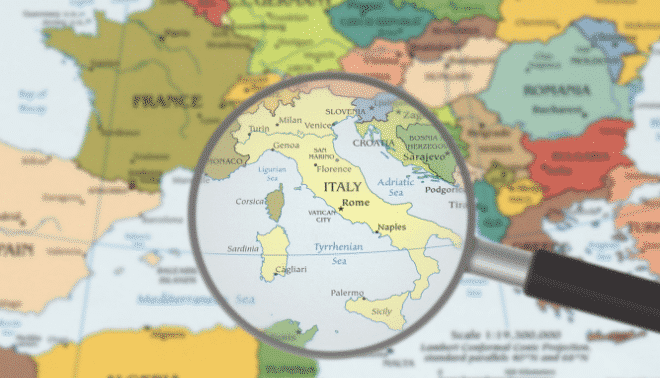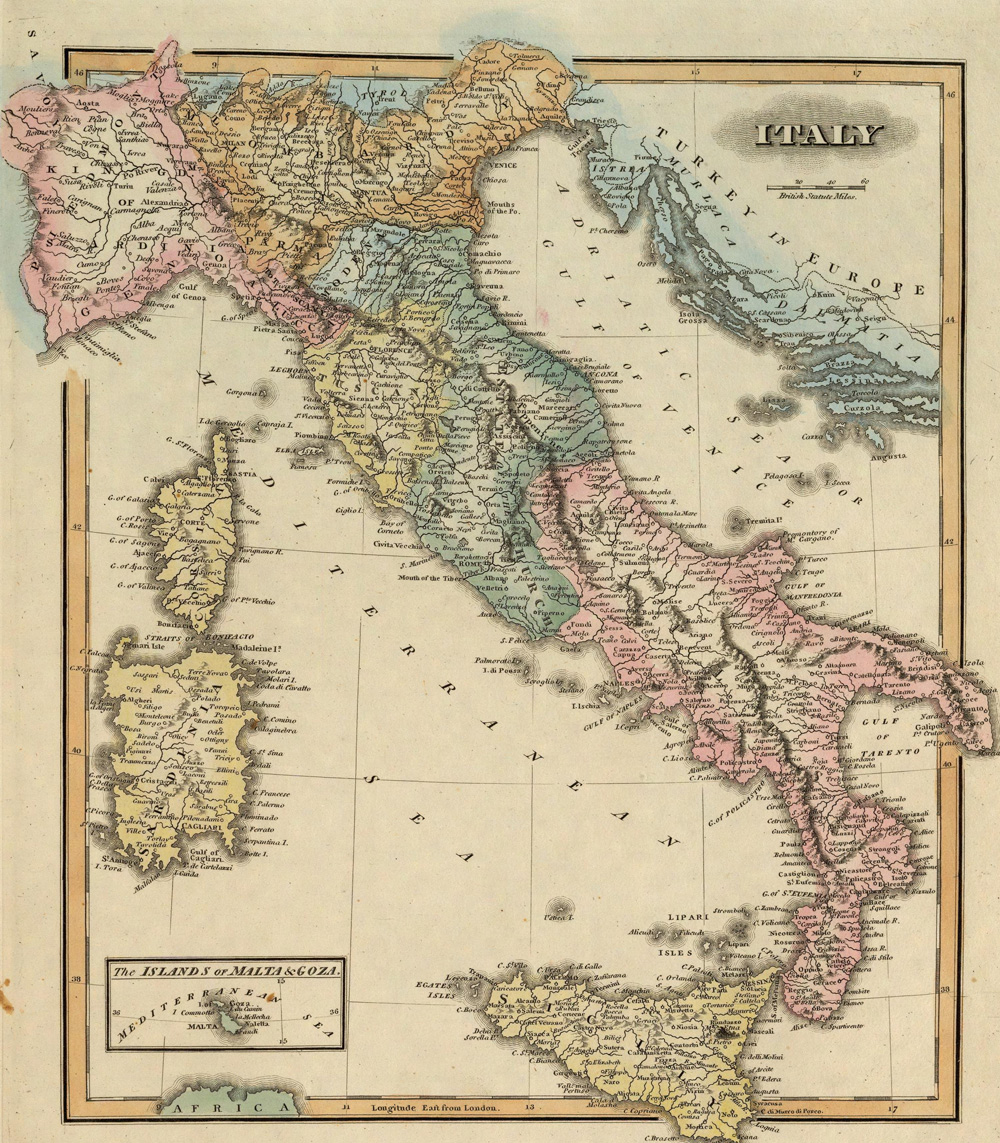Sign up for the Family Tree Newsletter! Plus, you’ll receive our 10 Essential Genealogy Research Forms PDF as a special thank you.
Get Your Free Genealogy Forms
"*" indicates required fields
Religion and family—two central elements to your Italian ancestors’ lives—come together in church records. Learn how to trace your roots in Italia with this essential resource.

Italy is so heavily Roman Catholic—some 90 percent of the population—that church traditions are woven into every aspect of Italian culture. More than 2,000 years’ worth of holy places form the setting for everyday life and attract millions of tourists each year, and towns honor their patron saints with annual festivals.
Naturally, then, church records are among the largest and most useful resources for researching roots in Italy. The Catholic Church kept only a few types of records, but these documents are genealogical goldmines. As early as the Council of Trent in 1563, priests and bishops recorded your Catholic ancestors’ baptisms, marriages, and burials in ecclesiastical registers held at church parishes and dioceses. Toward the end of the 17th century, Roman Catholic parishes also began keeping what amounts to parish censuses, used to track parishioners for taxation and sacraments.
In this article, taken from my book The Family Tree Italian Genealogy Guide, I’ll help you say “ciao!” to your Italian roots by finding five key types of church records.
Baptismal records
Baptizing their children was a high priority for Italian families. A child was usually baptized within three days of birth. If the record indicates a longer period of time between birth and baptism, the child may have been sickly or the family lived in a hamlet far from the nearest parish. The father, midwife or godparents usually presented the child to the priest for baptism; usually, godparents would serve in this role if the father was out of town or otherwise unavailable. Occasionally, you’ll find a child who was baptized twice, once in the womb by the midwife in case the child died during birth, and again after those fears proved unfounded.
Battesimo (sometimes called battezato) records, typically kept in paragraph format, are usually quite basic in terms of details they provide. You’ll find the date of baptism, sometimes the date of birth, the name of the father, the name of the child’s godparents, and the priest who baptized the child. A mother’s name is included about 40 percent of the time, but often without her maiden name. These records sometimes point you to other key life events, such as marriage and death.
Confirmation records
Records of cresima or conformazione document a person’s confirmation, a Catholic sacrament that typically was performed once a year when the bishop visited the parish. During the ceremony, a child (usually between 8 and 12 years old) would reaffirm his or her faith. Even now in Italy, a child’s confirmation is celebrated with pageantry, often with the child dressed in white and parading across town with family and priests. The ceremony and parade might be followed by a day of feasting with family and friends. Because age at confirmation could vary, you might see several children in a family receiving the sacrament at the same time.
Records include the date of confirmation, name and age of the child, and occasionally his father’s name. Use the age to estimate an ancestor’s birth when you can’t find baptismal and birth records.
Marriage records
Marriage rites in Italy could generate several kinds of records, including:
- Banns (bandi di matrimonio) announced an upcoming marriage, and would be read from the pulpit on three consecutive Sundays as well as posted on the door of the church. If the bride and groom belonged to different parishes, banns would be read and posted in both.
- Marriage dispensations (dispensazioni) can sometimes be found in the diocesan archives or attached to the parish marriage record. A dispensation allowed a marriage that otherwise would’ve been forbidden, such as if less than four degrees of familial relationship separated the bride and groom. In such as situation, the couple’s request could include a hand-drawn family tree depicting the relationship between the couple—a valuable resource for genealogists. A dispensation also might waive marriage banns if, for example, the bride was pregnant and the couple didn’t have time to wait to marry.
- Marriage records (contratto di matrimonio) come in multiple formats, depending when and where you’re researching. For example, before the year 1900, you’re more apt to see a marriage record that’s totally handwritten. Thereafter, priests often noted the information in columns on preprinted forms. A couple would be married in front of their parents and four witnesses, with a large celebration to follow. Parents with limited finances and multiple children of marriageable age might marry off two children at once, saving the cost of a second celebration. Always look at the records before and after your ancestor’s to see if it names a sibling.
Death and burial records
Parish death/burial records (sepolture) are usually brief, and often indicate any sacraments given immediately preceding the death. In fact, many parish death records provide death or burial information—not both. Older death records (mainly pre-1700) are more likely to document the burial and not the death.
A woman is often listed by first name only on parish death records. Her father might be listed with his surname, and you at least can get her married name from her husband’s information.
The size of a city may determine where a person was buried and how the burial place appears in records. Death records from small towns, for example, may lack the name of the cemetery because there was only one option. Records from large cities with multiple cemeteries usually do list a cemetery.
A burial record should note if an individual was buried within the church building, an honor usually reserved for the rich or for religious people who lived and worked on church grounds. The Oct. 28, 1741, death and burial record of Cattarina Ferrari, for example, states she was buried inside the Church of San Giacomo in Parma, in the northern Italian region of Emilia-Romagna. Although the document doesn’t give her the title of Sorella (Sister), it does refer to her 49 years of service at the hospital associated with San Giacomo—a clue that she may have been a nun.
State of the souls records
Status animarum (also called stato dello anime or stato d’anime), or “state of the souls” records are wonderful sources of genealogical information because they document whole family groups and their vital statistics, along with what sacraments each family member had received. Because several generations of an Italian family might reside in one household, this record can quickly expand the research on your Italian ancestors.
In 1614, Pope Paul V prescribed the keeping of these family books in Roman Catholic parishes worldwide. The intent was to record parishioners’ vital events and sacraments, but in Italy, they also were used for taxation. A potentially revolving door of priests created and updated the books during annual visits.
Despite potential inaccuracies and inconsistencies with other kinds of records, state of the souls records can be tremendously helpful in extending a family’s ancestry in areas of Italy that didn’t keep civil registration until the practice was adopted peninsula-wide in 1865. They’re also useful for tracking mobile ancestors as well as remote or rural localities with changing names. Social historians often use these resources to gauge a community’s population over time.
Records might be simply an entry on a single page, while later ones typically contain more information on two facing pages. Information recorded also varies by location and the priest’s education level. It often includes birth, marriage and death places and dates for each member of a household, plus women’s maiden names. Names of godparents are sometimes provided, as well as double surnames (such as “Martini Ardenghi Alessandra” for “Alessandra Martini Ardenghi”) and individual or family nicknames (“Maria Francesca, daughter of the deceased Francesco Petrogalli, also known as Zampeder”).
Records may contain more-obscure details, such as occupation and financial status. Depending on the year and diocese, confirmation may or may not be listed separately, and married children were noted on the parental families’ record with information about transfer to the entry for their marital household. You might find the sheet or page number of the new entry. Note that parishioners with cognitive and developmental disabilities generally weren’t recorded, as they didn’t receive sacraments and weren’t eligible for taxation.
The documents’ frequent use of abbreviations can make translation difficult. Some abbreviations include C or Con for confirmation or confession, C or Com for first communion, an X for “soon to be confirmed” (for children over 10 years old), and qnd for quondam or late (as in deceased).
Finding Italian church records
You’ll need to know your family’s town in Italy in order to find records of their parish. Look for this detail in US records such as family papers, church records of ethnically Italian churches, obituaries and naturalizations. FamilySearch has searchable indexes to Italian births, marriages and deaths that could provide a place. Once you find the town, look it up at Comuni Itali, which will list the local church(es).
FamilySearch also has digitized or microfilmed records for some areas of Italy. To find out which ones, run a Places search of the online catalog for your ancestral town and look under the church records headings. Catalog entries for online collections link to the digitized records, or you can find over 170 digital collections from Italy listed here by using the Place filter on the left to narrow the list to Continental Europe, then Italy. If the microfilm you need isn’t digitized, you can use the film at the Family History Library in Salt Lake City, hire a local researcher to do it for you, or send a record request to Italy. See a guide to writing and addressing your letter at Familysearch.org.
Most Italian church records are held in one or both types of these archives:
- Parish archives (archivio parrocchiale): Baptismal, marriage, confirmation and death or burial records are usually found in the parish, while the status animarum might be in either the parish or diocesan archives (see below). The physical archive might be in the church, an attached building, the priest’s residence, or another building across town. In large towns, pre-1900 parish records have likely been combined into a single archive in the mother church, a duomo (former cathedral) or cattedrale (cathedral).
- Diocesan archives (archivio diocesano): Marriage dispensations are almost always found in diocesan archives, as are records from defunct or closed parishes. In the northern areas of Italy for pre-1900 records, and throughout Italy for records thereafter, you also may find copies of baptism, confirmation, marriage and death records at the diocesan level. As mentioned, status animarum records might be here as well. Some records for larger cities may be found in an archdiocese (basically, a large diocese), but the archive is still called the archivio diocesano. Many dioceses and archdioceses have websites with hours of operation and instructions for requesting records. Some are partaking in La Memoria dei Sacramenti, a project that details each archive’s holdings and how to access them. See a list of dioceses listed here.
Italian church archives are often well organized and accessible only by appointment, so plan ahead if you want to travel to Italy to do the research yourself. Another option is to hire a professional genealogist in Italy; start your search for one with the Association for Professional Genealogists (APG) online directory. Read this article advice on working with a professional researcher.
Understanding the records
Church records are most often in Latin or Italian, but also may be in French or another language or dialect. You might even find multiple dialects within the same register or record.
It’ll help to familiarize yourself with the Italian genealogical words on the list a Familysearch.org as well as numbers, months and days of the week (the latter two aren’t capitalized in Italian). It can be difficult to distinguish among different numerals, so create a reference by photocopying the first nine records in the book. Numbers also might be spelled out, such as milleottocentosessantotto for 1868. September, October, November and December were sometimes abbreviated as 7mber, 8mber, 9mber and Xmber, respectively, in accordance with an older calendar that designated September as the seventh month of the year. Numeric dates are European style: 9/7/1892 is July 9, 1892. If you have several records to translate, it’s worth finding an Italian genealogy expert using the APG list. For help with a single record or two, search for Italian genealogy on Facebook to find groups of knowledgeable folks who can point out clues you missed in the records.
Melanie D. Holtz is a professional genealogist specializing in Italian research.






